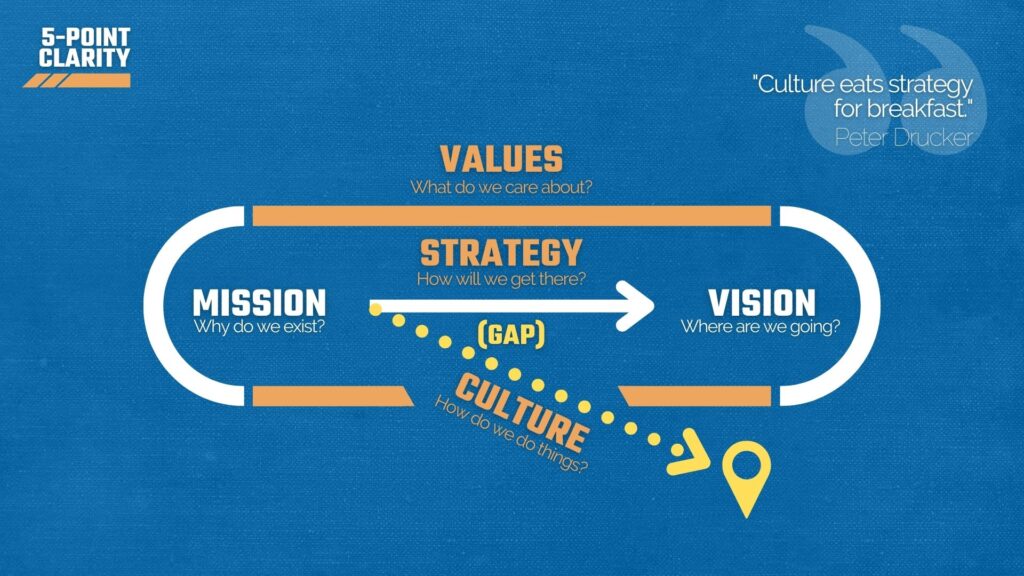5-Point Clarity for the Team

Every great team wants clarity. You can feel the difference when a team knows exactly who they are, where they’re going, and how they’re going to get there. People pull in the same direction. Conflict becomes productive. Accountability feels normal instead of threatening. And the mission actually advances.
But clarity doesn’t happen automatically. It requires leaders to slow down and systematically work through five core components—values, mission, vision, strategy, and culture—and then repeat those answers until the entire team can articulate them.
This article walks your leaders through a simple but powerful framework for organizational clarity, starting where clarity truly begins: your values.
1. Values: What Do We Care About Most?
Values answer the question, “What do we care about?”
Before you define mission or vision, you must define the non-negotiable behaviors and beliefs that shape how your team operates. Values set the tone for decision-making, communication, conflict resolution, and teamwork.
Most teams assume their values are obvious. They’re not. If you’ve never named them, clarified them, and reinforced them, people will fill in the blanks with their own personal preferences.
Clear values:
- Shape who you hire, coach, promote, and release
- Establish the expected behaviors for daily work
- Help everyone know how to act even when no one is watching
- Provide the guardrails for how your mission is lived out
Strong values aren’t aspirational—they describe what must be true in real life, not just in your branding.
Leadership tip: Choose 3–7 values, name them in simple language, and write one sentence explaining what each value looks like in action on your team.
2. Mission: Why Do We Exist?
Once your values provide the relational foundation, your mission defines the organizational purpose.
Mission answers the question, “Why do we exist?” It explains your team’s core job and the overarching contribution you’re trying to make. A mission statement should be simple, memorable, and inspiring.
A good mission statement:
- Acts like a compass, preventing drift
- Clarifies the ultimate purpose behind your work
- Helps teams decide what not to do
- Unifies people around meaning, not just tasks
When mission is unclear, teams lose focus. When mission is clear, teams gain energy and direction.
Leadership tip: Ask your top leaders to write their best one-sentence summary of why the team exists. If the answers differ, that’s a mission-clarity problem worth solving immediately.
3. Vision: Where Are We Going?
If mission provides purpose, vision provides the picture.
Vision answers the question, “Where are we going?” It describes a preferred future—what success looks like three, five, or ten years from now. Vision gives your people something to aim toward, not just something to work on.
Vision should be:
- Specific enough to imagine
- Inspiring enough to motivate
- Future-oriented but grounded in reality
Without vision, teams stay busy without moving forward. With vision, teams see how their daily work contributes to something bigger.
Leadership tip: Write a “future snapshot” that begins with: “Three years from now our team is…” Describe it in concrete, observable terms.
4. Strategy: How Will We Get There?
Once you know who you are (values), why you exist (mission), and where you’re heading (vision), the next question is “How will we get there?”
Strategy is the bridge between vision and daily execution. It identifies the big-ticket objectives—the major moves that will drive progress. Each strategic objective is broken into smaller, actionable steps so people know what to actually do each week.
Healthy strategy:
- Creates focus (3–5 priorities, not 20)
- Helps leaders sequence their efforts
- Filters out distractions, even “good” ones
- Provides measurable progress markers
Strategic clarity prevents “busy without impact” syndrome.
Leadership tip: Identify your top 3–5 strategic priorities for the next 12 months. If your list has 12 items, you don’t have a strategy—just a wish list.
5. Culture: Are We Doing What We Said We’d Do?
Here’s where everything rises or falls.
Culture answers the question, “How do we actually operate day-to-day—and does it match what we say we value and intend to do?”
Culture is not your posters, slogans, or onboarding documents. Culture is about accountability to your strategic objectives. It’s the lived reality of your habits, pace, communication norms, leadership behaviors, and decision-making.
This is where the concept of the culture gap becomes essential.
The Culture Gap: The Distance Between What You SAY and What You DO
Every organization has a gap between:
- Stated values and lived values
- Stated strategy and actual behavior
- Stated priorities and where time actually goes
This culture gap is the difference between your strategic objectives on paper and your real daily habits.
Examples of a culture gap:
- You say collaboration matters, but people work in silos.
- You say the priority is leadership development, but no one’s calendar reflects it.
- You say data matters, but decisions are made on gut instinct.
- You say excellence is important, but deadlines slip regularly.
Closing the culture gap requires:
- Honest assessment
- Clear accountability
- Consistent reinforcement
- Leaders modeling the behaviors they expect
Culture is the scoreboard of leadership. If your culture doesn’t reflect your strategy, your strategy will never become reality.
Leadership tip: Ask, “If an outsider tracked our calendars, conversations, and decisions for 30 days, what would they conclude our real strategy is?” That answer reveals the size of your culture gap.
Bringing the 5 Points Together
Use this framework with your leadership team:
- Define your values (relational clarity).
- Clarify your mission (purpose clarity).
- Paint your vision (future clarity).
- Identify your strategic objectives (execution clarity).
- Evaluate your culture and culture gap (accountability clarity).
Clarity cascades—from leaders to teams to daily habits. When a team aligns values, mission, vision, strategy, and culture, the entire organization becomes healthier, more focused, and more effective.
- Values: Which values currently shape your team the most—spoken or unspoken—and what values do you need to reinforce or redefine?
- Mission: How aligned are your top leaders when asked, “Why do we exist?” What drift do you need to correct?
- Vision: If you could snap a photo of your ideal team three years from now, what would be happening in that picture?
- Strategy: Which current projects truly support your strategic objectives, and which ones might be stealing focus?
- Culture Gap: Where is the biggest discrepancy between what your team says it is pursuing and what your team actually does each week?
- Accountability: What systems or habits could help close the culture gap and keep your strategic objectives from being forgotten in the daily grind?
- Leadership Modeling: What one behavior do you need to model more consistently to move your culture closer to your stated values and strategy?
Ready to bring 5-point clarity to your team? Schedule a consulatation.
Posts not found
5 Dysfunctions of a Team
Talking Points:
- Trust is the base for a functional team. If your team doesn’t trust each other they won’t be willing to work together to achieve the goals they’ve set. Lack of trust places your team into a cycle of dysfunction.
- Conflict is essential and can be productive in helping everyone voice an opinion. However, if the conflict in your team isn’t confronted correctly it can lead to dysfunction number three.
- When your team communication isn’t good it can lead to team member not committing to the decisions that are made. Reaching a consensus as a team isn’t really the end goal. The end goal is to have everyone voice their opinion.
- Lack of accountability is another way your team can fall apart. If members are defensive and can’t ownership for mistakes, it leads to further dysfunction.
- You need to have clarity on specific goals as a team. Make sure performance reports of team members are in line with the strategic objectives of your team.
- Initial reactions to this topic? What jumped out at you?
- Which of these five dysfunctions do you most commonly see within your team? How have those things impacted the team?
- Why is trust so important to a healthy functioning team? What happens when people get defensive about their mistakes? What happens when people are willing to own their mistakes?
- List some specific and practical ways you can combat these five dysfunctions.
- What are some other things, that aren’t on this list, that you have observed in your team that have had a negative effect on team performance? Other things that have had a positive effect?
- Is there a step you need to take based on today’s topic?
Adapted form Patrick Lencioni’s book The Five Dysfunctions of a Team
Your Culture Gets What It Pays For
Talking Points:
- Be honest about how you actually do things and take ownership of the results. If you aren’t honest about your culture and its outcome, then you are never going to get to the next level.
- If you are frustrated with the results you are getting it is probably because your culture doesn’t align with your vision. The results you are getting right now are the ones you deserve.
- Strategic re-alignment will help you turn today’s results into tomorrow’s vision. It will help you to bridge the gap between your current culture and your desired vision by using strategic objectives.
- The goal of strategic alignment is to integrate your culture, strategy, vision, and values into your mission as an organization, team, or family.
- Initial reactions to this topic? What jumped out at you?
- Write our your team’s vision: where you want to be in the next 3, 5, or 10 years.
- Write out your “culture” list: what you actually do on a regular basis. Cross off the items that represent sideways energy, directing you away from your vision.
- Write out your “strategy” list: the stuff you (or your team) should be doing on a regular basis.
- Make one more list: the roadblocks that might keep your team from aligning its culture with your new strategy.
- Is there a step you need to take based on today’s topic?
Amazon’s Flywheel: How Bezos Got to the Next Level
Talking Points:
- Jeff Bezos changed the way Amazon ran to take the company to the next level. He used a flywheel. A “flywheel” is a self-reinforcing loop that gets your team to the next level. Amazon started by adopting lower prices for commonly-bought items. This lead to more customers.
- As more customers flooded into Amazon, they were able to host more sellers. This allowed them to make even more money by taking a percentage of the income from each sale.
- As Amazon grew, it became more and more efficient in everything from their website to their distribution.
- Each of those four things allowed Amazon to create a virtuous cycle. If anything in that cycle grows, it will flow into the other areas and grow them as well.
- Initial reactions to this topic? What jumped out at you?
- What are some things you have purchased on Amazon?
- Do you think Amazon is a good example of success? Why or why not?
- What things would be on your flywheel? Why?
- Is there a step you need to take based on today’s topic?
Strategic Alignment
Talking Points:
- In order to get your team or organization to the next level, take some time to evaluate what you are trying to accomplish. Create the five boxes that will strategically develop your team.
- After you have determined what your five main strategic objectives are you should translate your tasks and goals into each box.
- Tasks are daily or weekly habits.
- Goals are typically quarterly or yearly projects.
- Think through your top five strategic objectives, how your daily tasks fit into those, and then bring it to your team.
- Initial reactions to this topic? What jumped out at you?
- What are your top five strategic objectives? Why are these your objectives?
- Do you have tasks that don’t fit into any of your five boxes? Are those things that are necessary or are they things you don’t necessarily need to be doing? Explain.
- How will strategic alignment help to take your team, organization, or family to the next level?
- Is there a step you need to take based on today’s topic?
How to Break Through Your Natural Ceiling of Achievement
Talking Points:
- The “Entrepreneurial” Approach: this approach involves relying on what you’ve always relied on to achieve success. But true success requires adaptation.
- The “Purposeful” Approach: this approach involves stepping out of your comfort zone to do what is necessary to achieve success. To be purposeful, look at others who have succeeded in your field and apply their strategies to your work.
- Initial reactions to this topic? What jumped out at you?
- Why do you think it’s so hard for people to break through their natural ceiling of achievement?
- Which of these approaches do you find yourself taking more often? Why do you think that is?
- What habits will you change in order to break through your natural ceiling of achievement?
- Is there a step you need to take based on today’s topic?
The ONE Thing: The Surprisingly Simple Truth Behind Extraordinary Results by Gary Keller
How to De-Fang Failure in the Workplace
Talking Points:
- Failure is inevitable in every workplace. Next Level cultures are fueled by failure, not defeated by it.
- Next Level cultures create ground rules for honest feedback about wins and losses.
- Initial reactions to this topic? What jumped out at you?
- Do you agree that failure is inevitable in the workplace? Which amount of failure is acceptable? When does failure become catastrophic?
- Share about a time when you or your team failed and handled it poorly. In retrospect, how could you have handled it differently?
- Why do most teams fail to talk honestly and openly about failure? What is the unintended consequence in the culture?
- What are some ground rules you would like to see established in your company’s culture when it comes to talking about failure? Make a list.
- Is there a step you need to take based on today’s topic?
Adapted from The Power of the Other by Dr. Henry Cloud.
How a SWOT Analysis Can Help Your Team
Talking Points:
- The goal of a SWOT analysis into gain a clear assessment of your present and future as a team, organization, or company.
- Start by analyzing the internal strengths and weaknesses (SW) of your organization.
- Next, analyze the external opportunities and threats (OT) of the marketplace where you operate.
- Doing a SWOT analysis can give you a lot of clarity on the present and future of your organization.
- Initial reactions to this topic? What jumped out at you?
- What is the best strength of your team, organization, or company? Your worst weakness? How do you know?
- Did your SWOT analysis give you clarity? Explain.
- How do you hope to see your team, organization, or company change in the future? What do you need to implement right now to start on the path toward a brighter, more successful future?
- Is there a step you need to take based on today’s topic?
How to Spread the Leadership Virus
Talking Points:
- The preaching method is the leader speaks the message to everyone at once. This is more of a top-down approach.
- The mentoring model means first-tier leaders mentor and communicate the mission, vision, and values of the team to their circle of influence, teaching them how to do the job and to mentor their subsequent circle of influence.
- The mentoring method can spread your values quickly in your organization by equipping your leaders throughout your organization with the system, the system tools, the training, and the message you want to be sure is spreading.
- Initial reactions to this topic? What jumped out at you?
- Describe your own “leadership model.” Do you tend to (1) tell everyone what to do or (2) equip and empower mentors to own and spread the message? Where did you learn your leadership skills?
- Do you know of any team or organization that uses the “mentor model” of leadership? If so, describe what it is like. Is it effective?
- Do you think your team or organization needs a leadership overhaul? Why or why not?
- Is there a step you need to take based on today’s topic?


